Are you dreaming of an extraordinary South American adventure? Bolivia, with its surreal landscapes and vibrant culture, awaits. SIXT.VN is here to guide you through the must-see sights and experiences in Bolivia, ensuring a seamless and unforgettable journey. Discover the best of Bolivia’s travel destinations, from the majestic Lake Titicaca to the otherworldly Salar de Uyuni, and explore unique cultural experiences and natural wonders.
Let SIXT.VN assist you in planning your dream Bolivian adventure, providing travel tips and essential services for an immersive cultural experience and a memorable vacation, including guidance on local cuisine, cultural etiquette, and responsible tourism practices.
1. What Makes Lake Titicaca a Must-See Attraction in Bolivia?
Lake Titicaca is a must-see attraction in Bolivia as it’s the highest navigable lake in the world and offers stunning views. Travelers often visit the resort town of Copacabana to enjoy these views and savor freshly caught trucha. The Inca’s believed this lake to be the birthplace of their empire, adding to its allure.
1.1. Why is Lake Titicaca So Special?
Lake Titicaca isn’t just any lake; it’s a place of great historical and cultural significance. Its high altitude and stunning natural beauty make it a unique destination. According to UNESCO, the lake and its surrounding areas hold immense cultural value, with archaeological sites and living traditions that date back thousands of years.
1.2. How to Explore Isla del Sol?
A boat trip from Copacabana to Isla del Sol is an excellent way to experience Lake Titicaca. On the island, you can discover ancient Inca ruins and observe the Aymara villagers farming the land and tending to sacred sites. Walking across the island offers breathtaking scenery, making it a cathartic experience.
1.3. What to Do in Copacabana?
Copacabana is a charming town with many shops, restaurants, and bars. For the best views, hike to the summit of the “Stations of the Cross” walk. This vantage point provides a panoramic view of Lake Titicaca, showcasing its glimmering glory.
1.4. What Kind of Tours are available on Lake Titicaca?
Fully immersive tours are the best way to enjoy Lake Titicaca. Tours range from 2-hour excursions to full-day adventures and homestay tours, where you can spend the night with local families. These experiences provide a deep dive into the local culture and natural beauty.
2. What is So Significant about Tiwanaku?
Tiwanaku is a significant Pre-Columbian archaeological site in western Bolivia and a UNESCO World Heritage Site since 2000. It’s named after one of the most important civilizations before the Inca Empire and is among the oldest and highest urban cities ever built.
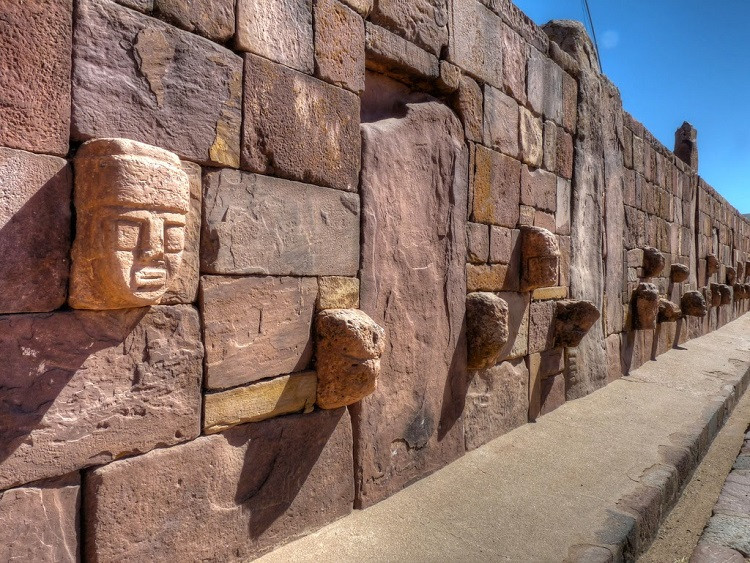 Tiwanaku ruins offer a glimpse into an ancient civilization
Tiwanaku ruins offer a glimpse into an ancient civilization
2.1. What Makes Tiwanaku an Enigma?
The mysteries surrounding its construction—how, when, and by whom—make Tiwanaku an enigma. The architectural structures defy explanation, posing more questions than answers for archaeologists.
2.2. What Can You See at Tiwanaku?
Visitors can see impressive architectural structures that showcase the advanced engineering and artistic skills of the Tiwanaku civilization. The site includes temples, pyramids, and monumental gateways, all made from massive stone blocks.
2.3. Why Should You Visit Tiwanaku?
If you’re fascinated by ancient civilizations and mind-boggling architecture, visiting Tiwanaku is a must. Its historical significance and architectural marvels provide a unique glimpse into the past.
2.4. Where is Tiwanaku Located?
Tiwanaku is located about 72 km (44 miles) west of La Paz, making it an easy day trip from the city.
3. What Attractions Does La Paz Offer Tourists?
La Paz offers tourists a blend of modern amenities and traditional culture set against a backdrop of snow-capped mountains. As Bolivia’s third most populous city and the world’s highest seat of government, it’s full of cafes, clubs, bars, restaurants, markets, and historic plazas.
3.1. How High is La Paz?
La Paz sits at a height of 4058 meters above sea level, making it essential to explore at a slow pace to avoid altitude sickness.
3.2. What is the Best Way to Get Around La Paz?
The best way to get around La Paz is by using the city’s extensive cable car system, Mi Teleférico. It offers stunning views and connects various parts of the city efficiently.
3.3. What Cultural Experiences Can You Have in La Paz?
You can immerse yourself in the rich culture of the Aymara people by visiting traditional markets, attending local festivals, and exploring historic sites such as Plaza Murillo and the Metropolitan Cathedral.
3.4. What Activities Can You Do in La Paz?
La Paz offers numerous activities, including exploring the Valley of the Moon, visiting the Witches’ Market, and taking a walking tour to learn about the city’s history and culture.
4. What is the Infamous Yungas Road Known For?
The Yungas Road, infamously known as ‘Death Road,’ is known for being one of the world’s most dangerous roads. It stretches 69kms from La Paz to Coroico, connecting the Amazonian rain-forest to the city.
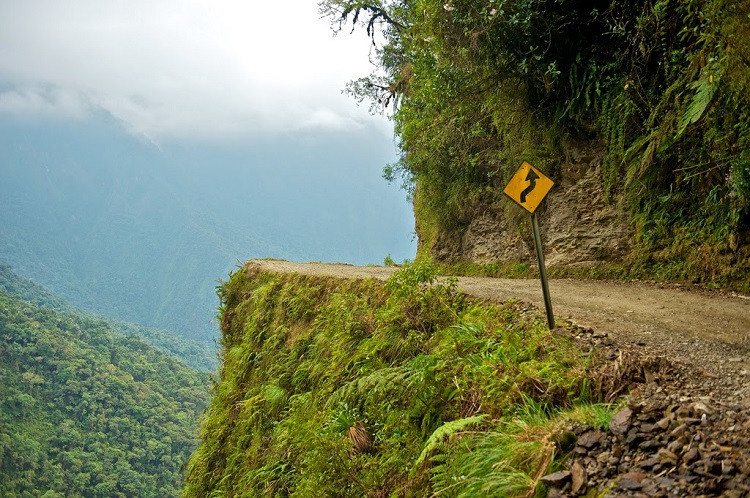 The Yungas Road, or Death Road, is a thrilling but dangerous bike ride
The Yungas Road, or Death Road, is a thrilling but dangerous bike ride
4.1. Why is it Called ‘Death Road’?
The road earned its grim name due to its high death rate. Its winding path, mountainous terrain, and terrifying precipices made it extremely hazardous.
4.2. Is Yungas Road Still Dangerous?
While a new, safer road has been built, Yungas Road still poses risks. Daredevil backpackers and local workers continue to use it, and accidents still occur. Since 1998, more than 30 cyclists have lost their lives on the road.
4.3. Can You Still Bike Down Yungas Road?
Yes, you can still bike down Yungas Road. It remains a popular activity for adventurous tourists seeking an adrenaline rush.
4.4. What Precautions Should You Take When Biking Down Yungas Road?
Ensure you choose a reputable tour company with experienced guides and well-maintained equipment. Wear appropriate safety gear, follow the guide’s instructions, and be aware of the road’s conditions.
5. What Makes Madidi National Park a Unique Destination?
Madidi National Park is unique because it’s one of the most bio-diverse places on the planet, spanning 7000 square miles from the Andes deep into the Amazon.
5.1. How Diverse is Madidi National Park?
The park boasts an incredible variety of flora and fauna, including winding rivers, rolling grasslands, mosquito-laden lakes, and steep slopes. It’s home to over 1000 species of birds and numerous mammals, reptiles, and insects.
5.2. What Can You See and Do in Madidi National Park?
You can take ecological and cultural tours to experience the jungle safely. Activities include spotting jaguars, learning about medicinal plants, and listening to the diverse birdlife.
5.3. How Do You Get to Madidi National Park?
Travel by boat from Rurrenbaque across the Beni River is the primary way to access Madidi National Park.
5.4. What Kind of Tours are Available in Madidi National Park?
Various ecological and cultural tours provide an authentic jungle experience. These tours range from short hikes to multi-day expeditions, offering something for every nature lover.
6. What Unique Attractions Can You Find in the Chiquitania Region?
The Chiquitania Region is a stunning, rarely visited area with exciting and unspoiled attractions such as the Santiago de Chiquitos Mirador and the hot thermal springs of Aguas Calientes. It’s known for its tropical savanna climate, Jesuit Missions, fascinating wildlife, and unique natural history.
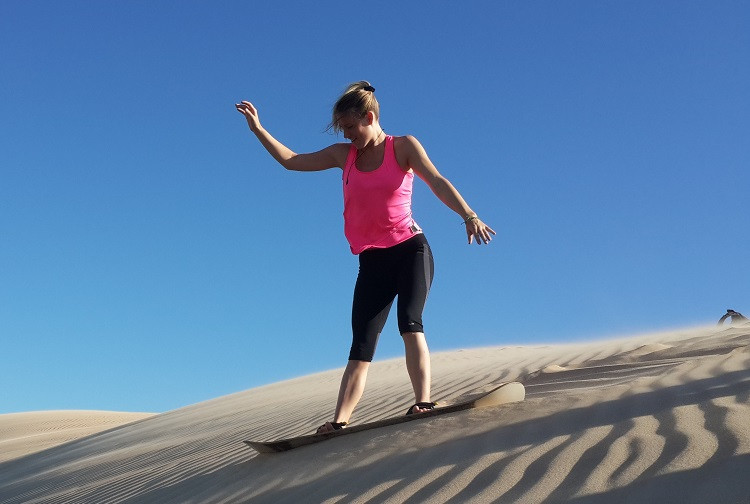 Explore the unspoiled beauty of the Chiquitania Region
Explore the unspoiled beauty of the Chiquitania Region
6.1. What Wildlife Can You See in the Chiquitania Region?
The region is home to diverse wildlife, including jaguars at Kaa Iya National Park. It’s a prime location for jaguar watching and observing other big mammals.
6.2. What Activities are Available in the Chiquitania Region?
Activities include sandboarding in Lomas de Arena and exploring the mysterious rock formations of the Santiago de Chiquitos Mirador.
6.3. Why is the Chiquitania Region Underrated?
Despite its beautiful attractions and unique offerings, the Chiquitania Region remains relatively unknown to tourists, making it an unspoiled gem.
6.4. What is the Best Time to Visit the Chiquitania Region?
The best time to visit is during the dry season (May to September) when the weather is more favorable for outdoor activities and wildlife viewing.
7. What Makes Oruro Carnaval a Famous Festival?
Oruro Carnaval is famous for its spectacular folk dances, extravagant costumes, beautiful crafts, and lively music. Held annually on the Saturday before Ash Wednesday, it draws crowds of up to 400,000 people.
7.1. Where is Oruro Carnaval Held?
The carnaval is held in Oruro, a mining town situated at dizzying heights in the arid Altiplano region of Bolivia.
7.2. What Can You Expect at Oruro Carnaval?
Expect up to 20 hours of continuous partying, featuring unique folk dances, extravagant costumes, and lively music.
7.3. Why is Oruro Carnaval So Popular?
The festival is a vibrant celebration of Bolivian culture and tradition, attracting both locals and tourists alike. It’s a unique and unforgettable experience.
7.4. How Can You Attend Oruro Carnaval?
Plan your trip in advance, as accommodations fill up quickly. Purchase tickets for the main events and be prepared for large crowds.
8. Why is Sucre Known as Bolivia’s Most Beautiful City?
Sucre is known as Bolivia’s most beautiful city due to its pristine and historically significant buildings, earning it a UNESCO World Heritage designation. Founded by the Spanish in the 16th century, it offers a wealth of cultural activity.
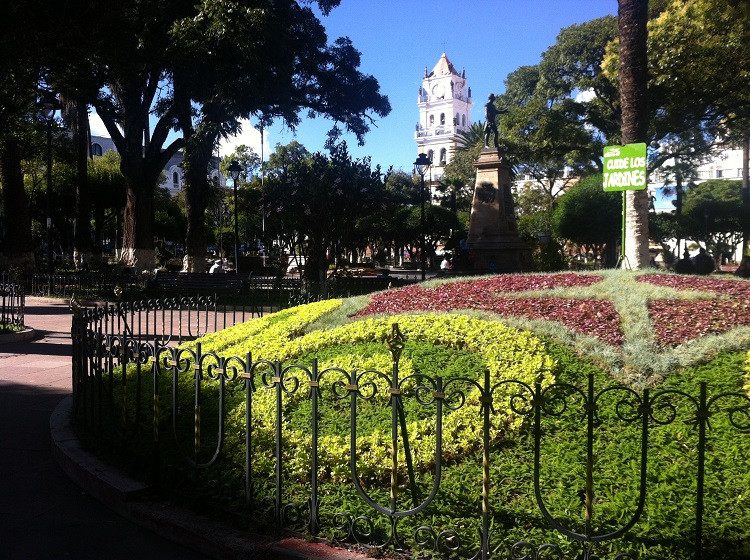 Sucre's colonial architecture makes it a beautiful city
Sucre's colonial architecture makes it a beautiful city
8.1. What Makes Sucre Ideal for Travelers?
Sucre is ideal for travelers because it’s one of the cheapest and safest cities in South America. It’s a great place to recharge, study Spanish, and immerse yourself in the local culture.
8.2. What Cultural Sights Can You Explore in Sucre?
Explore fascinating sights such as the Casa de la Libertad, where Bolivia’s declaration of independence was signed, and the Recoleta Monastery, offering stunning views of the city.
8.3. What Activities Can You Enjoy in Sucre?
Enjoy free events, explore cool places to go out, and immerse yourself in the youthful city’s vibrant atmosphere.
8.4. Why is Sucre a UNESCO World Heritage Site?
Sucre is a UNESCO World Heritage Site because of its well-preserved colonial architecture and historical significance, reflecting its rich cultural heritage.
9. What is the Story Behind Cerro Rico in Potosi?
Cerro Rico, looming over Potosi, is notorious for claiming the lives of Bolivia’s hard-working men and children. Rich in natural resources, it once made Potosi the wealthiest city in the Americas.
9.1. Why is Cerro Rico So Dangerous?
The mountain is dangerous due to the lack of infrastructure and inadequate safety equipment, leading to millions of workers losing their lives while extracting silver.
9.2. What is Potosi Like Today?
Despite its past wealth, Potosi is now one of the poorest cities in South America, with many men working in unstable, mineral-depleted mines.
9.3. Can You Tour Cerro Rico?
Yes, tourists can take guided tours through the mountain’s narrow tunnels to witness the perilous conditions miners endure.
9.4. What Should You Expect on a Tour of Cerro Rico?
Expect to learn about the difficult conditions miners face, including difficulty breathing, lack of food, and long hours. The tour provides a sobering look into their daily lives.
10. What Makes Salar de Uyuni a Must-Visit Destination?
Salar de Uyuni is a must-visit destination as the world’s largest salt flat. It offers some of the most unique and breathtaking scenery on earth, once an inland ocean covering most of the Altiplano.
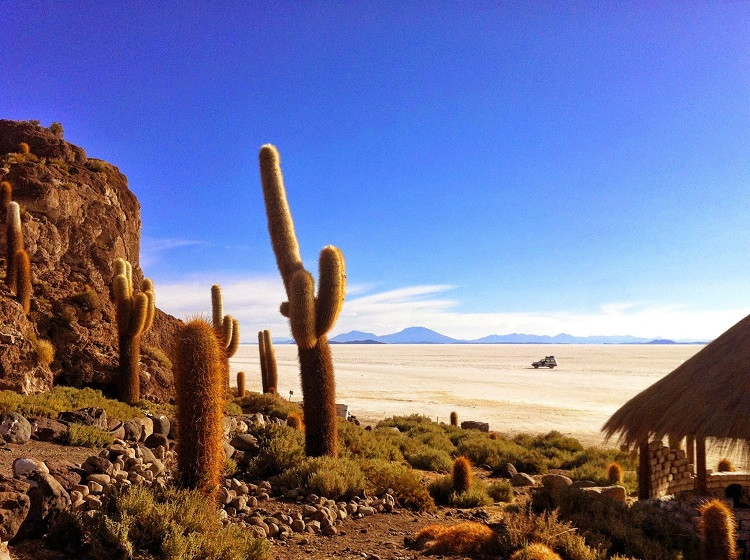 The Salar de Uyuni offers unique and breathtaking scenery
The Salar de Uyuni offers unique and breathtaking scenery
10.1. What Unique Landscapes Can You See at Salar de Uyuni?
You’ll see landscapes change quickly, from flamingos on high-altitude lagoons to islands covered in cacti. When it rains, the flats turn into the world’s largest mirror.
10.2. What Wildlife Can You Encounter at Salar de Uyuni?
You can encounter various wildlife, including llamas, flamingos, and vizcachas.
10.3. What Activities Can You Do at Salar de Uyuni?
Taking “perspective pics” is a popular activity. You can also sleep on beds made from salt and soak in natural hot springs under Bolivia’s moonlit sky.
10.4. What Tours are Available at Salar de Uyuni?
You can visit the salt flats with a full-day tour or a 3-day tour, both offering unique experiences and sights.
11. What Makes Samaipata Known as “The Little Switzerland of Bolivia”?
Samaipata is known as “The Little Switzerland of Bolivia” because of its stunning landscapes, stylish hangouts, ancient history, and peaceful nature walks. It’s a popular weekend retreat for Bolivia’s wealthier residents.
11.1. What is There to See and Do in Samaipata?
Samaipata’s main attraction is El Fuerte, a World Heritage pre-Inca archaeological site with the largest carved stone in the world. You can also explore Parque Nacional Amboró.
11.2. What Wildlife Can You Find in Parque Nacional Amboró?
The park boasts over 912 species of birds and over 177 mammalian species, including pumas and the rare spectacled bear.
11.3. Why is Samaipata a Relaxing Hideaway?
The town offers a tranquil environment for those looking to relax and enjoy peaceful surroundings.
11.4. What is the Meaning of Samaipata?
The name Samaipata comes from the Quechua language and means “Rest in the Highlands.”
12. What Makes the Tarija Wine Region Unique?
The Tarija Wine Region is unique because it’s the highest wine producer in the world, growing grapes at an elevation of around 1800 meters (6000 feet).
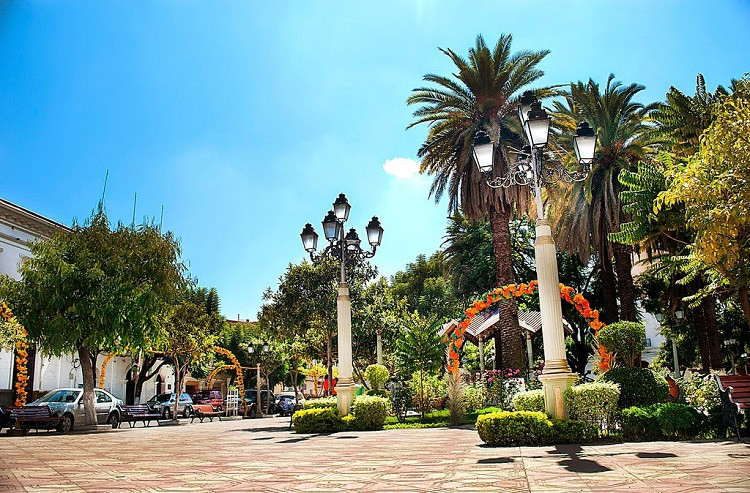 Tarija is Bolivia's wine region
Tarija is Bolivia's wine region
12.1. What is the Climate Like in Tarija?
The scenic area enjoys a Mediterranean climate, making it ideal for wine production.
12.2. What Wines Can You Sample in Tarija?
Sample a variety of fruity reds and floral whites, as well as the local specialty – singani.
12.3. What Food Should You Try in Tarija?
Try culinary treats such as grilled bife de chorizo and local favorite, dulce de lacayote (caramelized squash).
12.4. What is Tarija City Like?
Tarija is one of the fastest-growing cities in Bolivia, with contemporary art galleries, bustling markets, and youthful bars.
Bolivia is an adventure waiting to happen, and SIXT.VN is your perfect partner to make it seamless and memorable. Let us handle the logistics while you focus on creating unforgettable memories.
Ready to explore the wonders of Bolivia? Contact SIXT.VN today to book your services and embark on the adventure of a lifetime. Visit SIXT.VN or call +84 986 244 358 for personalized assistance. Our address is 260 Cau Giay, Hanoi, Vietnam.
FAQ: Your Questions About Tourism and Attractions in Bolivia Answered
1. What is the best time to visit Bolivia?
The best time to visit Bolivia is during the dry season, from May to September, when the weather is more predictable and ideal for outdoor activities.
2. Do I need a visa to enter Bolivia?
Visa requirements vary depending on your nationality. Check the latest visa regulations with the Bolivian embassy or consulate in your country before traveling.
3. What vaccinations do I need for Bolivia?
Consult your doctor or a travel clinic about recommended vaccinations for Bolivia, including yellow fever, typhoid, and hepatitis A.
4. How do I deal with altitude sickness in Bolivia?
Acclimatize gradually by spending a few days at a lower altitude before ascending to higher elevations. Drink plenty of water, avoid alcohol and heavy meals, and consider taking medication like Acetazolamide (Diamox) if recommended by your doctor.
5. Is it safe to travel in Bolivia?
While Bolivia is generally safe, it’s essential to take precautions. Be aware of your surroundings, avoid walking alone at night, and protect your belongings from theft.
6. What is the local currency in Bolivia?
The local currency in Bolivia is the Boliviano (BOB). U.S. dollars are widely accepted in tourist areas, but it’s helpful to have some local currency for smaller establishments and markets.
7. What language is spoken in Bolivia?
The official languages of Bolivia are Spanish, Quechua, Aymara, and Guarani. Spanish is most widely spoken, especially in urban areas.
8. What should I pack for a trip to Bolivia?
Pack layers of clothing to accommodate varying temperatures, comfortable walking shoes, sunscreen, a hat, sunglasses, insect repellent, and any necessary medications.
9. How do I get around in Bolivia?
Options include buses, taxis, and domestic flights. Buses are the most common and affordable option for long-distance travel.
10. What are some cultural etiquette tips for visiting Bolivia?
Respect local customs and traditions. Ask for permission before taking photos of people, dress modestly when visiting religious sites, and be polite and patient in your interactions.



